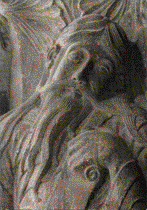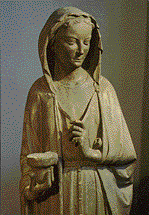

he Middle Ages is of course more than buildings and manuscripts and
objects, though. It's about people--people who come to life in the pages
of the work of writers like Chaucer, the
Beowulf poet, the genius
who composed
Sir Gawain and the Green Knight, and my own research
subject: Charles of Valois, duke of Orleans.
People also live in history books,
and, if you treat them right, they'll walk out of those history books and
into your life--people like Charles' brother, the count of Dunois. He
unashamedly styled himself the Bastard because he was--the bastard son of
Louis d'Orleans, brother of King Charles VI of France. The Bastard was
also a loyal supporter of his older half-brother Charles during the
latter's twenty-five year imprisonment in England. A hero on the
battlefield, he defended Charles' lands against both the English invaders
and the greedy nobles in the lands around Orleans. He managed Charles'
estates, husbanded his dwindling funds (ever going to make up the enormous
ransom the English demanded for the duke), and supported the cause of
Joan of Arc, one of whose primary goals was getting Charles back to
France. If there ever was a perfect hero, it was The Bastard, whom
Charles' mother Valentina took in out of the generosity of her heart and
raised as one of her own.

 ou'll also encounter
medieval people sometimes "in the flesh," or rather in wood or stone.
This impressive face belongs to the prophet Jeremiah. The full-length
figure, carved in low relief, is part of the portal (doorway) at the
little abbey of Moissac, in southern France. He holds a scroll that
presumably carried a few words from the book of Jeremiah to identify him.
Carved in the twelfth century, the face looks almost Eastern in the style
of the hair, beard, and long moustache. The face is extremely peaceful,
as if he knows some spiritual secret that takes away the stress and
strain of life. It must have been a calming experience for the people of
Moissac to walk past him every time they entered or left the church. This
figure, too, was probably painted in life-like colors when it was first
made. Notice the "jewels" on the collar of his robe, just visible on his
right shoulder.
ou'll also encounter
medieval people sometimes "in the flesh," or rather in wood or stone.
This impressive face belongs to the prophet Jeremiah. The full-length
figure, carved in low relief, is part of the portal (doorway) at the
little abbey of Moissac, in southern France. He holds a scroll that
presumably carried a few words from the book of Jeremiah to identify him.
Carved in the twelfth century, the face looks almost Eastern in the style
of the hair, beard, and long moustache. The face is extremely peaceful,
as if he knows some spiritual secret that takes away the stress and
strain of life. It must have been a calming experience for the people of
Moissac to walk past him every time they entered or left the church. This
figure, too, was probably painted in life-like colors when it was first
made. Notice the "jewels" on the collar of his robe, just visible on his
right shoulder.

 his
lady, carved in stone, is from the biblical story of the Wise and Foolish
Virgins, the wise ones being those who are faithful. She stands (or
rather stood--she's been brought in out of the weather) in the south-west
doorway of Strasbourg Cathedral in France. Some sculptor in the
thirteenth century saw the possibility of representing her virtue by
making her beautiful, and he clothed her very simply in a real-looking
belted dress and a cloak with a hood to show off that beauty. In her
right hand she holds her pot of oil, identifying her as one of the
Virgins. Look at the way the sculptor has carved her left hand holding the
ties of her cloak away from her body.
his
lady, carved in stone, is from the biblical story of the Wise and Foolish
Virgins, the wise ones being those who are faithful. She stands (or
rather stood--she's been brought in out of the weather) in the south-west
doorway of Strasbourg Cathedral in France. Some sculptor in the
thirteenth century saw the possibility of representing her virtue by
making her beautiful, and he clothed her very simply in a real-looking
belted dress and a cloak with a hood to show off that beauty. In her
right hand she holds her pot of oil, identifying her as one of the
Virgins. Look at the way the sculptor has carved her left hand holding the
ties of her cloak away from her body.
 s the Romantics knew in the nineteenth century, there is nothing more
touching than the link between beauty and death (so here's my tribute to
the Romantics). Late medieval people,
though, had no urge to romanticize death in
any form, since they had lived through one of the most horrible disasters
in human history, the Black Death, a pan-European plague that some
scholars say killed as many as a third to a half of all its
inhabitants.
s the Romantics knew in the nineteenth century, there is nothing more
touching than the link between beauty and death (so here's my tribute to
the Romantics). Late medieval people,
though, had no urge to romanticize death in
any form, since they had lived through one of the most horrible disasters
in human history, the Black Death, a pan-European plague that some
scholars say killed as many as a third to a half of all its
inhabitants.
 Compare that estimate to the effects of any disaster you can
think of. One result of this mid-fourteenth-century bubonic plague was a
dramatic upswing in death imagery in art and literature. It inspired a
German artist to create a wooden statue of Death dressed as a monk, and a
French artist to create the so-called "Dance of Death," in which he
depicted people of every vocation, class, and gender being "danced" out
of this world by skeletons. The imagery was a hit, and copies in art and
verse followed in profusion.
Compare that estimate to the effects of any disaster you can
think of. One result of this mid-fourteenth-century bubonic plague was a
dramatic upswing in death imagery in art and literature. It inspired a
German artist to create a wooden statue of Death dressed as a monk, and a
French artist to create the so-called "Dance of Death," in which he
depicted people of every vocation, class, and gender being "danced" out
of this world by skeletons. The imagery was a hit, and copies in art and
verse followed in profusion.
Not every death image grew out of the plague experience, however.
Medieval people dealt with death in battle (as in the Hundred Years'
War) and diseases that were incurable, but they also knew that death was
every man's lot, and the wiser among them did not see death as the
ultimate enemy. (Come to think of it, in the seventeenth century,
John
Donne said much the same in his sonnet that begins, "Death be not proud,
though some have called thee mighty and dreadful. . . .) In an age of
 faith, death's victory was only a temporary
setback in man's search for God, and the cloistered religious (monks
and nuns) taught themselves that lesson by constructing monuments to death to
remind each other to "remember death" and be ready for it, so that
they could be prepared to spend eternity with God. The monks of the
monastery of St. Francis at Evora, in Portugal,
lined the inside of a chapel (called an ossuary chapel) entirely
with the bones of the monks who had died before them. Thighbones march up
the columns, while skull upon skull
marks the edges, and the ceiling is painted with more bones and mottos
meant to remind the monks to "think on death."
faith, death's victory was only a temporary
setback in man's search for God, and the cloistered religious (monks
and nuns) taught themselves that lesson by constructing monuments to death to
remind each other to "remember death" and be ready for it, so that
they could be prepared to spend eternity with God. The monks of the
monastery of St. Francis at Evora, in Portugal,
lined the inside of a chapel (called an ossuary chapel) entirely
with the bones of the monks who had died before them. Thighbones march up
the columns, while skull upon skull
marks the edges, and the ceiling is painted with more bones and mottos
meant to remind the monks to "think on death."
Is this morbid? Not if keeping death in mind will keep you from dying the
Great Death, the one from which you wake up in Hell. Besides, the wise
among us today will tell you that being ready to die makes life much
sweeter, every day more vividly real, all relationships very special.
Medieval men and women weren't masochists; they were on to something.
 ome people (even well-educated people) think of the Middle Ages as
a dark, boring time, when everyone was poor and spent their days doing
nothing but praying. Think about it. People are people, and whether
they have cell phones or not, they communicate. Whether they have
television or not, they want to be entertained. Whether or not they
have The Simpsons, they want to laugh. Whether or not they are pious,
they are going to have sex. They are people just like us, neither
more nor less good or bad--they just lived in a world where the rules
were very different. The folks who made Monty Python weren't far wrong
about a lot of things.
ome people (even well-educated people) think of the Middle Ages as
a dark, boring time, when everyone was poor and spent their days doing
nothing but praying. Think about it. People are people, and whether
they have cell phones or not, they communicate. Whether they have
television or not, they want to be entertained. Whether or not they
have The Simpsons, they want to laugh. Whether or not they are pious,
they are going to have sex. They are people just like us, neither
more nor less good or bad--they just lived in a world where the rules
were very different. The folks who made Monty Python weren't far wrong
about a lot of things.

 ell, thanks
for coming along. Hope you enjoyed the trip. Let me leave you with
a great truth about the Middle Ages: those folks even had a sense
of humor. If they hadn't, do you think one of them could have created
this little pane of stained glass for York Minster??
ell, thanks
for coming along. Hope you enjoyed the trip. Let me leave you with
a great truth about the Middle Ages: those folks even had a sense
of humor. If they hadn't, do you think one of them could have created
this little pane of stained glass for York Minster??